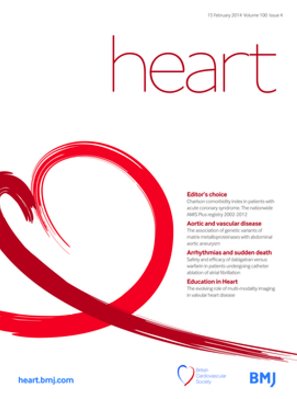Predicting future atrial fibrillation: risk factors, proteomics and beyond
IF 5.1
2区 医学
Q1 CARDIAC & CARDIOVASCULAR SYSTEMS
引用次数: 0
Abstract
The term ‘epidemic’ is increasingly used to describe the rising global prevalence of atrial fibrillation (AF). Recent estimates suggest that AF accounts for between 0.9% and 1.6% of total healthcare expenditure in the UK, forecast to rise to 4% over the next two decades.1 This trend—which is also anticipated internationally—underpins efforts to identify individuals at high risk of future AF, in addition to those with AF without manifest symptoms, in the hope of targeted prevention and early treatment. Indeed, numerous studies are currently investigating the impact of such approaches on clinical outcomes and healthcare utilisation. The association between AF and various conditions—including hypertension, heart failure, sleep apnoea and chronic kidney disease—is well-described, highlighting that AF is often a multisystem disorder. Accordingly, the management of AF has shifted towards a holistic and integrated approach, targeting comorbidities and risk factors, itself associated with improved outcomes.2 Before the actual onset of AF, some focus has been directed toward the identification of patients at high risk of incident AF. Various clinical risk scores have been proposed, such as the simple C2HEST score (ie, C2: Coronary artery disease/Chronic obstructive pulmonary disease (1 point each); H: Hypertension (1 point); E: Elderly (age ≥ 75 years, 2 points); S: Systolic heart failure (2 points); and T: Thyroid disease (hyperthyroidism, 1 point)).3 More complicated clinical risk scores have also been described for incident AF prediction, including the CHARGE-AF, Framingham and HARMS2-AF scores, as well as the CHADS2 and CHA2DS2-VASc scores (although the latter two were designed for stroke risk stratification, not for prediction of incident AF).4 Unsurprisingly, more complicated clinical risk scores will improve …预测未来的心房颤动:风险因素、蛋白质组学及其他
流行病 "一词越来越多地被用来描述全球心房颤动(AF)患病率的上升。最近的估计表明,心房颤动占英国医疗保健总支出的 0.9% 到 1.6%,预计在未来二十年内将上升到 4%。1 这一趋势在国际上也有预期,因此,除了那些有心房颤动但无明显症状的患者外,人们也在努力识别未来心房颤动的高危人群,希望能进行有针对性的预防和早期治疗。事实上,目前有许多研究正在调查这种方法对临床结果和医疗保健利用率的影响。心房颤动与各种疾病(包括高血压、心力衰竭、睡眠呼吸暂停和慢性肾病)之间的关联已得到充分描述,这突出表明心房颤动通常是一种多系统疾病。因此,心房颤动的管理已转向全面综合的方法,针对合并症和风险因素,这本身就与改善预后相关。2 在心房颤动实际发生之前,一些重点已转向识别心房颤动高风险患者。2 在心房颤动实际发生之前,一些人就开始关注如何识别心房颤动高危患者,并提出了各种临床风险评分,如简单的 C2HEST 评分(即 C2:C2:冠状动脉疾病/慢性阻塞性肺病(各 1 分);H:高血压(1 分);E:老年人(年龄≥ 75 岁,2 分);S:收缩性心力衰竭(2 分);T:甲状腺疾病(甲状腺功能亢进,1 分))。3 此外,还有更复杂的临床风险评分用于预测心房颤动事件,包括 CHARGE-AF、Framingham 和 HARMS2-AF 评分,以及 CHADS2 和 CHA2DS2-VASc 评分(尽管后两者是为中风风险分层而设计的,并非用于预测心房颤动事件)。
本文章由计算机程序翻译,如有差异,请以英文原文为准。
求助全文
约1分钟内获得全文
求助全文
来源期刊

Heart
医学-心血管系统
CiteScore
10.30
自引率
5.30%
发文量
320
审稿时长
3-6 weeks
期刊介绍:
Heart is an international peer reviewed journal that keeps cardiologists up to date with important research advances in cardiovascular disease. New scientific developments are highlighted in editorials and put in context with concise review articles. There is one free Editor’s Choice article in each issue, with open access options available to authors for all articles. Education in Heart articles provide a comprehensive, continuously updated, cardiology curriculum.
 求助内容:
求助内容: 应助结果提醒方式:
应助结果提醒方式:


